[bars]
Common Names: Congo African Grey, Red Tails
Scientific Name: Psittacus erithacus erithacus
Origin: Ghana, Zaire, Congo, Cameroon
Relative Size: 12 inches
Weight: 500 grams
Average Lifespan: 30-50 years
Egg Clutch: 2- 5 eggs, average is 3 eggs
Incubation: 28 days
Talking Ability: Superior
Congo African Grey
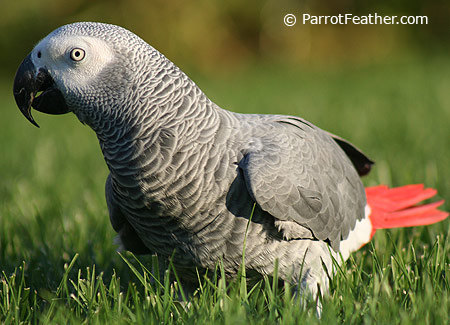
African Grey parrots are not colorful compared to other parrots. In fact, they are mostly all gray and look as if they have been dusted with soot. The only color that can be seen on these birds is the bright red color located on their tails. Nevertheless, these parrots are striking specimens that showcase hues of charcoal gray and white throughout their bodies. When in flight, their black wing feathers are exposed and their true elegance can be seen.
These graceful parrots have large black beaks. Their eyes, surrounded with bare patches of white skin, reveal bright yellow irises and prominent black pupils. For the most part, these birds cannot be sexed visually and therefore need a DNA test to determine their true gender. However, some experienced African Grey breeders are able to determine the sex of the birds as the males tend to have elongated skulls, larger beaks, and are larger in comparison to the females.
Unlike budgies and lovebirds, which are prized for their large assortment of color mutations, African Greys do not come in vibrant colors. There are some birds that will have a few red feathers throughout their gray bodies; however, most breeders do not charge for this rare occurrence.
[ads]
In small quantities, double factored African Greys are available; however, these birds are not usually sold as pets but kept for developing more mutations. Double factored African Greys have a red band of feathers on their chests and backs with an occasional cluster of red feathers on their heads and wings. If two birds of this same mutation are paired for breeding, they can produce solid red colored African Greys. This is such a rarity that it is highly unlikely they will be seen any time soon as pets.
African Greys in the Wild
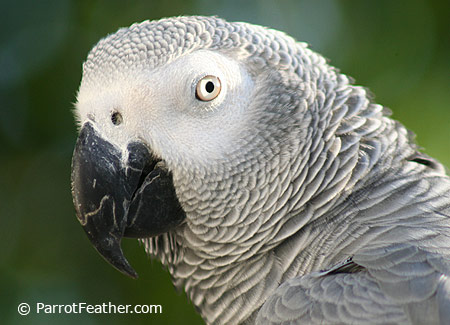
African Grey parrots are native to Western and Central African Rainforests. They live in dense jungles and are difficult to observe as their native habitat is difficult to trek. Ornithologists, who are lucky enough to study these magnificent parrots in the wild, find African Greys easiest to observe near forest openings comprised of hideouts made of forest branches and palm fronds. Once the birds do arrive, they can be spotted foraging together by the hundreds. They will nervously wander about the ground whistling, playing, and eating clay.
Though the exact reason is unknown why the parrots eat the clay, it is believed it provides extra minerals as well as detoxifies the parrot of any toxins ingested while in the forest. Along with the clay, these birds feed on shoots, tender plants, fruits, blossoms, and nuts.
Little is known about the parrots’ breeding habits in the wild. What is known is that during the breeding season, these birds will separate from their flock into pairs. The bonded pair will seek an older tree to nest in and it is believed they prefer darker locations. The female will prepare the cavity and expand it to her liking while the male stands guard. He will feed the female while she is incubating the eggs. Only when the chicks are old enough to produce their own warmth and the food demands increase, will the mother help to feed the chicks. The babies fledge around nine weeks. Thereafter, they will remain with their parents until they are independent – estimated to be around one year.
African Grey’s in Captivity
African Greys have been kept in captivity for hundreds of years. Next to the Indian Ringneck parrot, these birds were documented by the Greeks and Romans. These smart feathered friends have been kept by famed people such as King Henry VIII, Queen Victoria, Marie Antoinette, Angelina Jolie, and Hue Hefner.
African Greys are popular throughout the world and are continuing to spread as more people are discovering their talking abilities. In truth, the demand is so great that constant trapping of these parrots, as well as habitat destruction, have reduced their wild numbers to mere thousands. Trappers often use nets installed on the ground, or sticks covered in glue, to catch these birds. Once caught, many are stuffed into wooden crates and sold. Very few survive this traumatic treatment as the overall goal of the poverty stricken trapper is to make money and the parrot’s basic needs are neglected.
Thankfully, laws have been implemented in the United States and Europe stopping the importing of these birds. For this reason, many breeders have established healthy stocks for the pet trade. These parrots can easily be found and their prices are still not too expensive within the United States and Europe. Other countries, such as Australia, have very few of these parrots available and for this reason they can cost a great deal more.
Congo African Greys as Pets
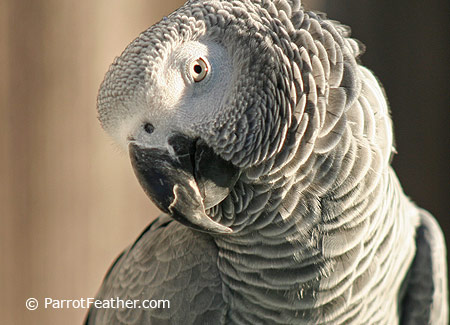
Like all parrots, African Greys are smart. They have been deemed the supreme parrot as their talking ability is superior. Quite frankly, no parrot can match the clarity, tone, or cognitive capability of the African Grey. These parrots seem to say the right things at the right time. Most pet Greys are extremely perceptive of the activity inside their home. For this reason, many African Grey parrots will know when their owners leave and return from work. In response to this daily schedule, they will greet them with a “hello” while franticly climbing about their cage waiting to be held. These birds can develop large vocabularies and many quickly learn to associate words with actions, toys, or activities.
It should be said that though African Greys are masters when it comes to talking; however, not all will do so. Many people purchase these birds hoping to have a talking parrot but then become disappointed if the parrot never learns to talk. The outcome is usually grave for the parrot because owners tend to ignore them if the birds don’t talk as expected. If this happens, it can result in serious psychological damage to the bird. These birds do not tolerate neglect as most will resort to plucking, self mutilation, or neurotic behaviors.
An owner who has just purchased a baby African Grey should note the first few years of the parrot’s years are critical when being introduced into the household. Proper socialization techniques should be used to ensure the parrot develops into a healthy bird that can tolerate stress. A great deal of effort should be made to expose the bird to new people, environments, toys, and foods. The parrot should also be taught to play alone as this seems to be the most common source of stress in handfed Greys. The bird should only be praised and rewarded for behaviors desired and negative behaviors ignored.
African Greys are not cuddly parrots such as cockatoos, lovebirds, or conures. Instead, they enjoy being perched on their owner’s shoulders. They seem to be perfectly content watching the world as long as they are near their owners. Watching television, reading a book, or working on the computer is a great way to spend time with an African Grey.
Toys for a Congo African Grey
These parrots require a play stand. It is important the owner designate an area for the parrot to swing, chew its toys, or climb. The stand should be made of metal or a hardwood as the parrot will quickly destroy it. Some owners will suspend ropes with attached toys from the cage ceilings. This seems to be highly enjoyed by the parrot as this quickly brings out the acrobatic side of the African Grey and allows them to swing and play.
Other items that should be used periodically are foot toys. These are clusters of wood, leather, or beads tied together so the parrot can spend its time chewing on it and breaking the toy apart.
Feather Picking
Unlike the Timneh African Grey, Congo African Greys seem to be more prone to feather picking. The reason for this remains a mystery, but there are common factors reported such as stress, loneliness, boredom, or a poor diet. The problem can be difficult to remedy once the parrot has started. If an owner should have to deal with this destructive behavior, the Grey should immediately be taken to a vet to rule out any bacterial infections, parasite invasions, or metal toxicity. If the blood work appears to be normal, the owner should look for other ways to simulate the bird or change its diet as the parrot may be malnourished. Feather picking is a complex issue and varies with each bird. If this is occurring, each bird needs to be evaluated as to how to correct the problem.
Breeding Congo African Greys
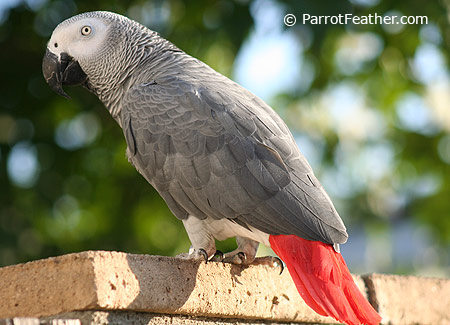
Congo African Grey parrots are not as difficult to breed as they were before due to existing established colonies and because many first time breeders find these birds to be enjoyable. It is important that research be done before pairing up these birds for breeding. This upfront research will help to minimize any complications down the road. For example, a female grey might not feed her babies upon hatching and immediate action is then needed to remove the babies to ensure their survival. Each breeding pair is different and only after a few breeding seasons and some trial and errors, will the owner be able to best pair their Greys.
Pairing Congo African Greys successfully can be a little tricky. Some breeders will let their Congo African Greys choose their mates while others will pair the birds and wait to see if they have any chemistry. The best African Greys for breeding are those who have been around other birds and are not too tame. If a bird has been tamed and seeks only human interaction, the chances of it breeding successfully can take many years. It is important to note that some tamed Greys may never become successful breeders as they are too interested in human interaction and thus makes them poor breeders.
Congo African Grey parrots are monogamous and will mate with their partner for life. Once the pair has bonded, they will continue to nest, preen, and live together throughout their long lifespan.
Before any parrot is placed into a breeding program, both birds should be in optimal health. Their eyes should be clear, their feathers pristine, and they should be sexually mature. Most Congo Greys reach maturity around four years; however, very few successfully raise a family before three years.
Their cage should be at least six feet wide, five feet high, and have a width of about six feet. It is also important the cage be suspended as this gives the birds more security. The cage frame should be made of metal as wood will quickly be chewed and the cage destroyed. The location of the cage should be placed in such a way the birds have enough privacy when breeding. Probably one of the most common reasons a pair of Congo Greys can’t successfully breed is due to a lack of privacy. Too much noise, attention, or other birds seems to hinder the birds from breeding.
Along with privacy and the proper cage, an L shaped nesting box should be provided. The box has proved time and time again that the birds like to nest deep into the box as this makes the chicks more difficult to remove by predators. Normal deep boxes can be used, but L shaped boxes seem to be more effective.
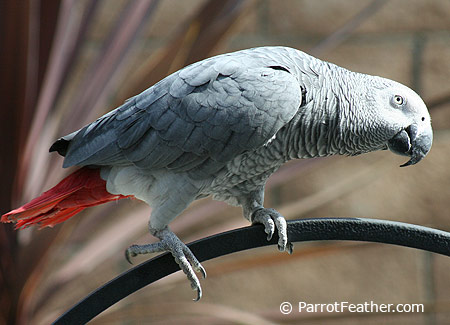
When the female Congo African Grey has successfully laid her eggs, the babies can be expected to hatch within 28 days. The female can lay as many as five eggs; however, the standard seems to be three eggs per clutch. The eggs are white and about the size of a walnut. An egg is produced every other day and incubation usually begins once the first or second egg is laid.
Breeding Seasons
Most parrots in general are triggered by seasonal events that stimulate breeding. Congo African Greys are no different. They prefer nesting in cooler months with less daylight while in captivity. For this reason, most Congo Greys start gearing up to breed around October in the United States. If kept outdoors and the birds are allowed to cycle through their normal breeding routine they can successfully produce two sets of babies per year.
If the pair is kept indoors, these birds can breed throughout the year. Many breeders will increase the amount of food as this helps to stimulate the hen to breed. If sufficient amounts of food are not present, the pair will most likely avoid breeding altogether. Whatever method is used, the hen should be given enough time to rest as too much breeding will deplete her minerals and will shorten her lifespan.
Nesting & Hatching
The temptation might be great for new breeders to inspect the nest weekly if eggs are laid or if chicks are believed to have hatched. This is not a good idea as this will most likely cause the female to abandon her nest. Instead, the breeder should look for signs the chicks have hatched as the female will only leave the box to go to the bathroom, look to see if more food is consumed, or listen for slight chirping sounds from baby chicks. Once these signs are obvious and about one month has passed since the first egg was produced, the box can be inspected. Doing this sooner could be disastrous.
The babies should remain with their mother for at least 15 days. This seems to be enough time to get the proper nutrients and ensures they will be healthy once they are juveniles. All the babies must be pulled for hand feeding as the mother will stop feeding the other chicks if only one is removed.
The babies will start to nibble on solid foods around eight weeks and start to wean around ten weeks. Some Congo Greys will wean around 12 weeks if housed alone. The breeder should continue to feed the chicks until they are fully weaned. Breeders should not deprive the chicks of food in order to make them start feeding independently. The chicks will eventually start eating on their own. Each chick is different and each chick will wean when it is ready. The breeder should wait at least one week after the bird is weaned before it is sent to its new home. The new owners should also practice spoon feeding their parrot as this will come in handy if medications are needed.
Congo African Grey Cages
Congo African Greys are acrobatic parrots. They love to swing from their toys and climb around their cages. Swinging seems to be such an enjoyable past time that most Congo African Greys will hang upside down and talk while delighting in this activity. For this reason, they need a great deal of space to burn off their extra energy.
The owner should always purchase a cage as large as their budget can afford. A cage that’s four feet in length, three feet in width, and 4 feet in height will do for starters. If possible, the cage should have a play stand installed on top of the cage as the bird will enjoy many hours there as well.
The cage should be powder coated and some cages can last 20 or more years if properly maintained. The bottom of the cage should have a grill to ensure the parrot does not have access to spilt food, droppings, or any of the bacteria that resides there. A tray that can easily slide out for cleaning is important as this will need to be emptied and cleaned daily.
Feeding Your Congo Grey
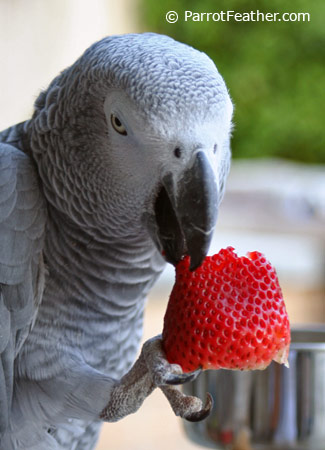
Probably one of the most important aspects of keeping any African Grey is maintaining a proper diet. These birds do not do well on diets only consisting of seeds. In fact, a diet only comprised of seeds offers little nutrition and will cause serious problems down the road such as seizures due to a lack of calcium or problematic ailments due to a lack of Vitamin A.
These birds need to be feed a base diet of seeds, avian pellets, vegetables, and fruits. These various foods should be rotated daily to provide the various nutrients that are needed to keep a bird healthy. African Greys seem to like different textures, colors, and tastes in their foods. Do not be afraid to experiment with a variety of foods.
Weekly cuts of fresh broccoli, kale, and spinach should be given to keep calcium levels up. Other sources of calcium can be found in Brazil nuts, almonds, flax seeds, and oranges. Many owners will make shish kabobs with steamed squashes such as pumpkin, zucchini, butter nut squash, cooked sweet potatoes, carrots, or cantaloupe. Brightly colored peppers such as bell peppers, jalapenos, Anaheim chilies, Fresno peppers, or Poblano peppers are enjoyed as well.
Approximately once or twice a week, the bird should be given some form of protein such as chicken or turkey. African Greys are opportunistic feeders and will eat anything we eat. It is important the food not be processed as this will make the bird overweight.
Foods that should never be given to an African Grey are chocolate, avocado, onions, or alcohol. These food items can make the parrot ill and lead to its death.
If a Congo African Grey is fed the proper diet, most can reach into their mid thirties without problems—some have even been recorded to live well into their fifties.
[ads]
